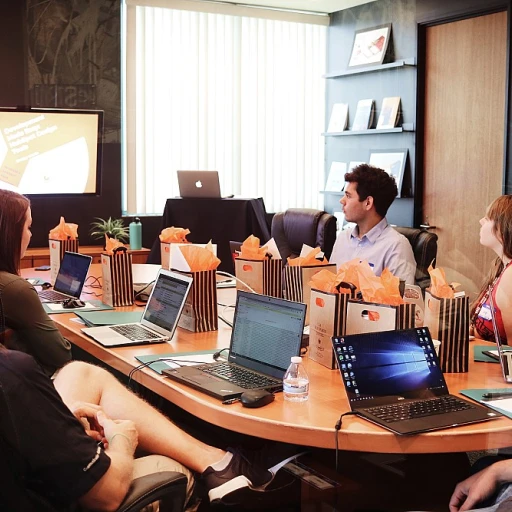
Understanding the Evolving Risk Landscape
Grasping the Current Risk Landscape
In today's dynamic environment, understanding the evolving risk landscape is imperative for C-suite executives. This landscape is continually shaped by emerging threats, regulatory changes, and the rapid advancement of technology. Organizations are now faced with multi-dimensional risks ranging from cyber threats and data breaches to environmental and supply chain disruptions. To navigate these complexities, leaders must adopt enhanced strategic measures.
With the integration of big data and analytics into risk management, businesses can gain valuable insights into potential risk factors. Real-time data analytics provide a proactive approach to identifying and mitigating risks, enabling quicker and more informed decision-making. Moreover, cutting-edge technologies like machine learning enhance the accuracy and efficiency of risk assessment processes.
Financial institutions and other sectors heavily reliant on risk assessment practices are particularly adept at leveraging advanced tools to predict and manage financial liability and other business risks. As the landscape shifts, the need for adaptive risk mitigation strategies becomes even more critical. Employing data-driven insights and fostering a culture of risk awareness can empower organizations to not only respond to current threats but also anticipate future challenges effectively.
Integrating Technology in Risk Assessment
The Transformative Role of Tech in Risk Evaluation
As the corporate landscape continues to evolve at a rapid pace, the significance of integrating cutting-edge technology in risk assessment cannot be overstated. Harnessing the power of data analytics and machine learning allows organizations to anticipate potential disruptions and craft effective risk management plans that align with strategic objectives. In this bid for resilience, technology emerges as both a shield and a compass.
Incorporating big data into your risk assessment toolkit offers a comprehensive view of both internal and external factors influencing your business environment. Not only does it enhance cyber risk management by providing insights into emerging threats, but it also addressees financial institutions complexities through real-time analytics.
Leveraging Real-Time Insights
Real-time monitoring through innovative technology such as IoT and AI has become indispensable for monitoring supply chain risks and ensuring seamless operation continuity. Deploying sensors and leveraging data analytics helps leadership maintain oversight on potential bottlenecks and vulnerabilities. This predictive capacity isn't limited to operational hazards, but also extends into areas like cyber insurance and environmental factors, enabling more agile decision-making.
Enhancing Liability Management with Data
In today’s interconnected world, the synergy of technology and risk assessment not only curtails excess liability but also paves the way for new risk solutions that were once deemed impossible. Equipping your teams with the necessary tools to dissect patterns found in historical data aids in effectively strategizing liability management alongside employee benefits offerings.
To cultivate an ecosystem where innovative approaches to risk management thrive, leaders in the C-suite need to champion technological integration. Thus, capitalizing on the transformative power of digital advancements in developing and implementing robust risk strategies creates real and enduring benefits for all stakeholders involved.
Building a Culture of Risk Awareness
Fostering a Risk-Savvy Culture Across the Organization
Developing a risk-aware culture within an organization is vital for effectively managing and mitigating potential threats. It's not just about having a risk management plan in place—it's about embedding a deep understanding of risks and their implications throughout every level of the business. This cultural shift empowers employees to recognize and respond to risks in real time, thus bolstering the organization’s resilience. The integration of a risk-centered mindset can begin with clear communication of risk management goals linked to the company's broader strategic objectives. Employees should be encouraged to actively engage with risk data and analytics, turning everyday observations into actionable insights that benefit the organization.Training and Education as Catalysts
Training programs are foundational to cultivating a culture that values risk-awareness. They ensure every team member, from new recruits to seasoned executives, understands both the nature of risks—be they cyber, financial, environmental, or supply chain—and the strategies necessary to mitigate them. Utilizing cutting-edge data analytics and machine learning tools can enhance these training efforts by offering real-time insights and predictive capabilities.Encouraging Open Dialogue
An open-door policy fosters a sense of trust and transparency—crucial components of a risk-aware culture. Encouraging employees to communicate their concerns or observations relating to risks ultimately strengthens the business's ability to respond adeptly. By using collaborative platforms and real-time communication channels, organizations can facilitate the flow of information regarding potential threats, ensuring swift action. For more strategies on crafting an effective communication framework for strategic risk management, consult this executive briefing as part of your toolkit.Adaptive Risk Mitigation Strategies
Adapting to Unforeseen Challenges
As the business landscape becomes increasingly unpredictable, organizations must adopt adaptive strategies to address emerging risks. Flexibility is key in managing the complexities of risk management, especially when faced with rapid technological advancements and evolving threats such as cyber risks and environmental concerns.
To navigate these challenges, integrating machine learning and big data analytics into risk assessment processes can provide valuable insights. These technologies help in identifying patterns and predicting potential disruptions, enabling companies to design preemptive measures. For instance, data analytics can offer real-time monitoring of supply chain vulnerabilities, thus allowing businesses to make informed decisions swiftly.
Moreover, regularly updating the management plan is crucial for ensuring that it aligns with current business objectives and market demands. This dynamic approach aids in addressing not just immediate threats but also long-term risk exposure, including excess liability and financial risks.
Implementing adaptive risk mitigation requires collaborative efforts across various departments. Employee benefits programs can play a significant role by fostering a culture of risk awareness and encouraging proactive measures among staff. Communicating the importance of continuous improvement in risk strategies generates a shared responsibility mindset.
As organizations strive for resilience, considering external risk solutions such as cyber insurance and specialized environmental services can offer additional layers of protection. By leveraging these cutting-edge solutions, businesses can bolster their defenses against unforeseen liabilities.
Collaboration and Communication in Risk Management
Facilitating Open Channels of Communication
In the realm of risk management, communication is not just an operational formality; it is a strategic necessity. For organizations aiming to leverage innovative risk management solutions, fostering open channels of communication across all levels can significantly enhance risk awareness and proactive management.
Key strategies to facilitate effective communication include:
- Implementing regular cross-departmental meetings to ensure that all stakeholders are abreast of potential risks and mitigation strategies. This helps in aligning objectives and enhancing the collective ability to respond to challenges.
- Utilizing data analytics tools to present clear and concise information regarding financial, environmental, and cyber risks. Leveraging technologies such as big data and machine learning ensures that decision-makers have access to real-time updates and predictive insights.
- Creating platforms for knowledge sharing, enabling employees to share their insights and experiences related to risk management.
The Role of Technology in Enhancing Communication
Digital transformation continues to reshape risk management strategies. By integrating cutting-edge tools, organizations can bolster their communication frameworks, driving informed decision-making processes. For instance, Google Scholar can be referenced to ensure strategies and solutions are grounded in credible and authoritative sources.
The incorporation of social collaboration tools and project management platforms facilitates seamless collaboration and improves the speed at which risk information is disseminated across departments and teams.
Engaging the Workforce in Risk Discussions
A successful organizational culture prioritizes employee engagement in risk conversations. This not only empowers employees but also equips the leadership with varied perspectives that enhance risk identification and mitigation. Regular training sessions on emerging risks, such as cyber risk and supply chain vulnerabilities, enrich the organization’s proactive defense mechanisms.
Effective risk management involves a holistic approach where every stakeholder, from the front-line employee to the C-suite executive, plays a crucial role in identifying, communicating, and addressing potential liabilities. This collaborative effort stands to bring about immense benefits, not only mitigating financial loss but also establishing comprehensive governance over potential risks.
Measuring and Evaluating Risk Management Success
Effective Metrics and KPIs
Measuring success in risk management involves a nuanced approach to determine how strategies are performing. Establishing clear metrics and Key Performance Indicators (KPIs) provides a quantifiable method to evaluate the effectiveness of your risk management plan.
- Data Analytics: Utilizing data analytics, businesses can track real-time performance of risk strategies employing big data analytics to predict potential risks and assess current ones.
- Risk Solutions: Continuously reviewing and updating risk solutions ensures they evolve with the business landscape, making use of insights derived from data.
Monitoring and Adjustment
An effective risk management strategy demands continuous monitoring and the flexibility to adjust as necessary. With advancements in technology like machine learning and data analytics, organizations can achieve more responsive and adaptive risk strategies.
- Environmental and Cyber Risks: Regular assessments allow for timely updates and changes, particularly essential for managing environmental and cyber risks.
- Real-Time Adjustments: Real-time monitoring systems aid in identifying emerging risks before they become disruptive, enabling immediate adjustments to control measures.
Feedback Loops
Incorporating feedback loops in your risk management framework is vital. It provides ongoing insights by involving employees from all levels, fostering a culture of risk awareness discussed in previous sections.
- Employee Benefits: Acknowledging feedback regarding risk from employees can enhance their commitment and introduce new perspectives on potential risks.
- Collaborative Effort: As noted earlier, collaboration is crucial, and feedback from all departments strengthens the overall risk management effort.
Documenting Outcomes
Comprehensive documentation of risk management endeavors allows organizations to trace the evolution of their strategies and refine them over time. Well-documented processes enable businesses to understand not only the successes but also the areas needing improvement.
- Project Outcomes: Documenting outcomes provides a project-oriented perspective on the impact of specific strategies.
- Historical Analysis: Providing historical data for risk management practices aids in forecasting and planning future risk mitigation initiatives.
Measuring success requires a multifaceted approach that takes into account real-time data, environmental considerations, and feedback loops, all of which create a dynamic and effective risk management framework.














